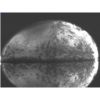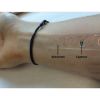Micro and Nanosystems group

HAADF transmission electron micrograph of the AlN/ZnO/IDT(Au/Ti)/LiNbO3- Y128 trilayer structure.

Wireless surface acoustic wave sensor "tattooed" on the skin.

Supporting device based on a piezoelectric polymer membrane for middle ear surgery.
Last publications
- Exploring the flexibility of gapless and gapped devices using PVDF-TrFE-CTFE-rGO-KNbO3 nanocomposite films for energy harvesting applications
Karthik Vinodan, Raneesh Balakrishnan, Nandakumar Kalarikkal, Shaik Ruksana Begum, Prabavathi Munirathinam, Arunkumar Chandrasekhar, Didier Rouxel
Materials Science and Engineering: B, 2025, 315, pp.118084. ⟨10.1016/j.mseb.2025.118084⟩ - Flexible Piezoelectric and Hybrid Nanogenerators Based on Single Layered and Stacked Multilayered PVDF/CoFe2O4/KNaNbO3 Composite Electrospun Nanofibers
C.S Chitra Lekha, Sreelakshmi Moozhiyil Purushothaman, Shaik Ruksana Begum, Prabavathi Munirathinam, Arunkumar Chandrasekhar, Maïté Fernandes Tronco, Marc Ponçot, Bruno Ameduri, Sabu Thomas, Isabelle Royaud, Didier Rouxel, Nandakumar Kalarikkal
Polymer, 2025, pp.128257. ⟨10.1016/j.polymer.2025.128257⟩ - Increasing the sensitivity of Love wave MSAW sensors by magnetoelastic layer thickness variation
P. Mengue, S. Hage-Ali, S. Petit-Watelot, S. Zhgoon, M. Hehn, O. Elmazria
Smart Materials and Structures, 2025, 34 (2), pp.025031. ⟨10.1088/1361-665X/ada859⟩
Presentation
The main topic of the Micro and Nanosystems research group is the field of microsensors and other piezoelectric microdevices (actuators, energy harvesting, etc.).
Its expertise ranges from the development of piezoelectric materials (polymers, thin films) to devices, especially medical ones. The skills acquired pass via micro and nano-manufacturing techniques for the production of multifunctional microsensors/actuators. The group relies on theoretical approaches to reach the expected characteristics in accordance with the targeted applications.
The group’s recognition is reflected by numerous funded projects and international collaborations. These projects focus, inter alia, on the development of:
- micro-sensors which are able to withstand extreme environments (thin-film alloys, self-protected structures),
- a micro monitoring device for the ear surgery (vibration sensor based on piezoelectric polymer)
- acoustic stimulators for mechanical-biological characterisation.
These achievements position the group at the forefront in the field of functional materials, micro-sensors and piezoelectric micro-devices.
The Micro and Nanosystems group develops and characterizes functional materials, in particular piezoelectric and thin-film materials, for the production of acoustic wave microdevices. It also structures those functional materials and integrates them into microdevices and systems, which intended to be promoted to industrial partners. The main application fields are the health, the industry 4.0, and the Structural Health Monitoring (SHM).
Research topics
Biosensor and wave / living interaction
Surface acoustic wave microdevices allow the stimulation, characterization and detection of healthy human cells and tumour cells. For this purpose, numerical models are developed to highlight the wave / biological fluid interactions (heating, mixing, etc.) and to determine the keys parameters of the devices (nature of the materials, frequency, power, bandgap of the phononic structures, vibration modes, etc.).
Two steps follow:
- the study of the cells’ behaviour under a mechanical excitation. The mechanobiology field is an emerging topic in the group which aim to quantify and understand how cells react to mechanical forces as a function of the wave frequency, power and dose. A better understanding of the involved processes (viscoelasticity modification, cytoskeletal structure change, shear modulus difference, etc.) would allow an early diagnosis by dissociating healthy and tumour cells, and thus would lead to medical treatments such as tissue regeneration for example.
- the development of different systems (phononic pillars, multi-frequency, magnetic trapping) to exacerbate the sensitivity and to probe at different depths to characterize the biological fluid with cells.
Projects:
- PHC CNRS France/Malaisia 2020-2021
- Institut Carnot-ICEEL + FEDER (CAP-MAT): 2020-2021
- PHC Hibiscus France Malaisie 2020-2022
- International Emerging Action (IEA CNRS) IJL-UCSD, California, USA
Thesis:
- CNES / Université de Sherbrooke (Canada), cotutelle, Jérémy Bonhomme, defended on 3rd december 2020
- Bourse ministère - Université de Lorraine, Lucile Olive, 2018-2021
- CONACYT / Université de Sherbrooke (Canada), Pedro Aleberto Segura Chavez, 2017-2022
- Bourse Gabon, Doll Spencerh Bidouba Sanvani. 2019-2022
Article:
Love waves dispersion by phononic pillars for nano-particle mass sensing, J. Bonhomme et al., Appl. Phys. Lett. 114, 013501 (2019), Numerical Characterization of Love Waves Dispersion in Viscoelastic Guiding-Layer Under Viscous Fluid, J. Bonhomme et al., Journal of Applied Physics, Vol.128, Issue 15, 2020, DOI: 10.1063/5.0022797
Micro-sensors and instrumentation
The group develops miniature, passive, acoustic wave micro-sensors that can be remotely interrogated for a wide range of applications, focusing on the Industry 4.0, the structural health monitoring (SHM) or the biomedical area. To overcome a given challenge driven by physical quantities (temperature, stress, pressure, magnetic field, etc.), the group carry out research work ranging from the development of functional and innovative materials to the transducer integration in the communicating system including the design, the production and the characterization. The on-board antenna is also optimized to meet the adaptation constraints, size limitations and operating conditions.
These micro-sensors with neither electronics nor embedded energy are particularly attractive in harsh environments (high temperatures, corrosive environments, radiative environments, etc.), for a use on rotating parts or parts with very limited access, or for human body applications ("electronic tattoos").
Projects:
- ANR PRC WSSTITWIN : 2020-2023
- Institut Carnot-ICEEL + FEDER (CAP-MAT): 2020-2022
- ANR JCJC SAWGOOD : 2018-2022
- ANR PRC Immunanocaps: 2016-2020
- Institut Carnot-ICEEL 3less: 2018-2019
- ANR PRCE SALSA : 2015-2019
- ANR PIA2 Impact 2016-2020: Nanomaterial for Sensors (N4S)
- PHC Amadeus France-Autriche (IJL-CUAS) 2022-2023
Thesis:
- Florian Bartoli (Bourse CentraleSupélec), defended on 5th April 2019
- Harshad Mishra (Bourse ISITE LUE N4S), defended on 18th November 2019
- Cécile Floer (Bourse DGA) defended on 20th November 2019
- Prince Mengue (Bourse Gabon) defended on 16th June 2022
- Baptiste Paulmier (Bourse DGA-Pôle M4), 2019-2022
- Jordan Maufay (Bourse ISITE LUE internationale), 2019-2022
- Ulrich Youbi (Bourse Gabon), 2021-2024
Piezoelectric polymers and nanocomposites for microsensors
The group manufactures flexible films with excellent piezoelectric properties. In addition, it is an expert of PVDF and P(VDF-TrFE) polymers with or without nanofillers designed using "clean room" microtechnologies. These two factors have enabled the development of an integrated vibration sensor in a supporting device for the middle ear surgery. This sensor is based on a flexible piezoelectric nanocomposite membrane which allow to test the transmission of elastic waves along the ossicular chain.
In the field of polymers and nanocomposites, the research work is based on a long-standing collaboration (Memorandum of Understanding 2013, renewed in 2018 with Mahatma Gandhi University, Kerala, India), in particular with Professor Sabu Thomas (http://www.sabuthomas.com/ ), a world reference in the field of polymer nanocomposites (h index: 106). One of the areas of collaborative studies initiated is the promotion of eco-design and the use of natural materials.
Projects:
- Programme International de Cooperation Scientifique (PICS) CNRS Inde NASA (2017-2019)
- International Research Partnership (IRP) CNRS Inde APONAMA (2022-2026)
- Programme Indien SPARC : « Bio-filler-Interfaced Electrospun PVDF Hybrid Piezoelectric Generator for Mechanical Energy Harvesting » (2019-2023)
- 2 programmes ISITE-LUE Professor@Lorraine des Pr Sabu Thomas (2018-2022) et du Pr Nandakumar Kalarikkal (2019-2022
Theses:
- Bicy KOTTATHODI (Bourse indienne), soutenue le 13/01/2020
- Sunija SUKUMARAN (Bourse ISITE LUE N4S) soutenue le 30/08/2021
- Thibault TRICARD (LUE, projet exploratoire Orthosis4D) soutenue le 8/04/2022
- Maïté FERNANDES TRONCO (Thèse LUE Internationale) : 2021-2024
- Sreelakshmi MOOZHIYIL PURUSHOTHAMAN (Thèse CEFIPRA) : 2022-2025
Know-how
Elaboration
- Development and characterization of functional materials, especially piezoelectric materials and thin films, crystalline and polymeric materials, for the manufacturing of microdevices notably acoustic wave devices.
- Manufacture of surface acoustic wave sensors (temperature, magnetic field, stress and deformations, pressure, fluid, etc.). The specificity of the sensor comes from the multilayer structures that includes functional films judiciously selected and elaborated.
Characterization
- Piezometry, elastic properties by Brillouin light scattering spectroscopy
- Antenna and micro-sensor characterization in an RF anechoic chamber (400 MHz- 9GHz)
- RF characterization of surface acoustic wave sensors:
- temperatures up to 600°C under RF probes and up to 900°C if packaged
- under magnetic fields,
- under stress,
- pressure 10-6 Torr to 104 Torr.
Technology transfer
- Device for Peroperative Monitoring of Ossicular Mobility During Middle Ear Surgery(DAMCOM): in progress with SATT SAYENS.
- NanoCaps Maturation Project in progress
Members
Professors, assistant professors
- Thierry AUBERT
- Omar ELMAZRIA
- Cécile FLOER
- Sami HAGE ALI
- Didier ROUXEL
- Frédéric SARRY
Technical and support staff
- Hamid M'JAHED
- Stefan MC MURTRY
Post-doctoral researchers
- Ulrich YOUBI
PhD students
- Léna Cassandra ABEGUE MBA
- Clémence BISCARA
- Laurine MEISTERSHEIM
- Jessica MONALDI
- Freddy NZE
- Kevin RIZK
- Michael SEYFRIED
Emeritus
- Jean-René CUSSENOT
Publications
Contact
Head of the group
Thierry AUBERT
thierry.aubert@univ-lorraine.fr
+ 33 (0) 3 72 74 25 27
Nancy-Artem
Institut Jean Lamour
Campus Artem
2 allée André Guinier - BP 50840
54011 NANCY Cedex
